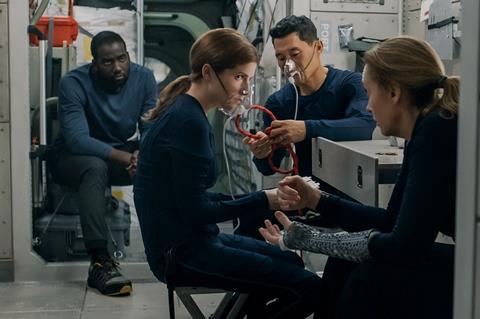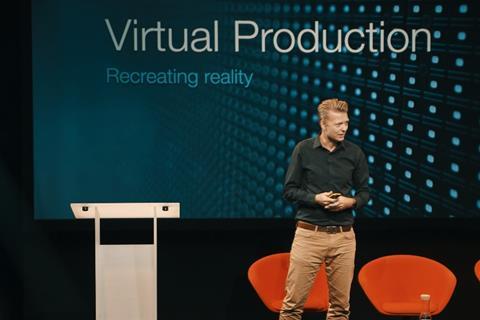
The metaverse and virtual production as sources of opportunities for traditional filmmakers were among the hot topics of this year’s Geneva Digital Market (GDM).
The 10th edition of the industry platform of Geneva International Film Festival (GIFF) ran November 7-11 as an hybrid event with its programme of talks mounted in studio 4 of Swiss broadcaster RTS’s headquarters for the first time.
GIFF artistic director Anais Emery introduced GDM panel ‘Gamefiction of Cinema: How to shoot your next movie in the metaverse’ to outline “concrete opportunities the metaverse can bring to the creative industries.” She warned filmmakers, cinematographers, producers and techies the goal of the session “is not to say that the metaverse is a new Eden for audiovisual but really to bring deeper knowledge about what and how you can collaborate and maybe how you can be inspired by this possibility.”
Laura Olin, COO and partner at Finland’s ZOAN, the leading European metaverse studio founded by creative tech pioneer Miikka Rosendahl, warmed herself to creatives by quickly confessing she was not a tech person.The ZOAN-created and operated metaverse platform Cornerstone.land is where users can buy plots of land and build photorealistic headquarters and housing on an virtual island. NFTs, audience participation and crypto currencies and ways of engaging people and getting them to create are on the agenda.
“We have already talked with some film festivals about the possibility of having virtual cinemas in this metaverse,” said Olin.
She predicted the advent of metaverse-based talent, in the way that Instagram and TikTok have created their own stars and communities over the last 10 years.
“Coming up, we have the ‘Generation One’ avatars later this year,” Olin said. “I hope we can start creating the next steps the future of the film industry within Cornerstone,” Olin said. “We dream about a film being set up and shot in Cornerstone land.”
Fellow Fin Mikko Kodisoja, the founder and CEO of Fireframe Studios, a virtual production (VP) company with an in-camera visual effects (ICVFX) stage in Helsinki, detailed his move from games to filmmaking. Kodisoja founded Supercell, the maker of the mobile game Clash Of Clans and Europe’s first decacorn (a company worth more than $10 billion). Kodisoja says video game engines can have a fundamental impact on the workflows for a feature film.
When US filmmaker and actor Cinqué Lee arrived in Fireframe Studios in Helsinki to discuss the production of his Norway-set mountain cable car thriller A Rare Grand Alignment, Kodisoja knew the control, safety and speed of shooting on the ICVFX stage made production sense. The Fireframe team worked the whole script in to a game machine programme, filmed in Norway with VR capture and then spent 18 days in the ICVFX studio.
“Film is increasingly incorporating these technologies,” Kodisoja said. “The biggest difference I always see between films and games is that in games you’re an active observer, and in film you want to be the passive observer. You want to enjoy the story told by someone else.”
Tech intelligence

As part of a series of sessions under the banner ‘VP Toolkit for film professionals’ produced by GDM content consultant and Cannes NEXT and Marche du Film and Accelerate head Sten-Kristian Saluveer, GDM attendees were also treated to the latest intelligence from virtual production gurus including award-winning Norwegian film director and cinematographer Jannicke Mikkelsen.
Mikkelsen warned virtual production is not for every project.
“If the answer to the questions ‘can I travel to my desired location?’ and ‘is the location easily recognised?’ is both no then virtual production is the answer,” said Mikkelsen, whose recent credits include augenschein and XYZ Film’s sci-fi thriller Stowaway, starring Anna Kendrick and dircected by Joe Penna. Mikkelsen’s title on the film is ‘virtual cinematographer’, a reflection of the emerging role created when virtual production meets traditional filmmaking.
Patrick Morris, director and co-founder of Paris and Barcelona-based Appia Agency, an LED screen-shoot specialist and VP manager, noted Netflix has drawn up “guidelines and best practice to make virtual production work.”
Nordisk Film Shortcut VFX veteran Martin Madsen from Denmark, whose credits include Only God Forgives, has built a state- of- the- art LED studio in Copenhagen. “To avoid the pitfalls [of VP] , you need to have somebody who is skilled and knowledgeable onset. A DP might not realise there’s anything wrong with changing the shutter speed or changing certain settings, but for virtual production, that can have an implication,” noted Madsen.

The UK’s Louisa Bremner, a consulting VP supervisor at the Lux Machina outfit whose credits include films and TV projects such as House Of The Dragon, Matrix 4 and Death On The Nile believes VP will help democratise filmmaking “High-end VP software creation is available online for free. You can get started really quickly,” she said.
Saluveer noted VP is a cost-effective line to put in a budget. European VP studios cost anything from €8,000 to €15,000 a day to hire, compared to up to €100,000 for large- scale facilities for studio level productions.
“Putting a budget line in for LED Studio hire in Europe is prudent contingency should the location shoot go awry,” he said.
The GDM is overseen by head of digital Paola Gazzani Marinelli; GIFF will close on November 13.























No comments yet